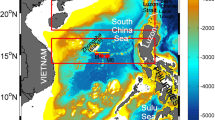Abstract
OCCAM global ocean model results were applied to calculate the monthly water transport through 7 straits around the East China Sea (ECS) and the South China Sea (SCS). Analysis of the features of velocity profiles and their variations in the Togara Strait, Luzon Strait and Eastern Taiwan Strait showed that: 1) the velocity profiles had striped pattern in the Eastern Taiwan Strait, where monthly flux varied from 22.4 to 28.1 Sv and annual mean was about 25.8 Sv; 2) the profiles of velocity in the Togara Strait were characterized by core structure, and monthly flux varied from 23.3 to 31.4 Sv, with annual mean of about 27.9 Sv; 3) water flowed from the SCS to the ECS in the Taiwan Strait, with maximum flux of 3.1 Sv in July and minimum of 0.9 Sv in November; 4) the flux in the Tsushima Strait varied by only about 0.4 Sv by season and its annual mean was about 2.3 Sv; 5) Kuroshio water flowed into the SCS in the Luzon Strait throughout the year and the velocity profiles were characterized by multi-core structure. The flux in the Luzon Strait was minimum in June (about 2.4 Sv) and maximum in February (about 9.0 Sv), and its annual mean was 4.8 Sv; 6) the monthly flux in the Mindoro Strait was maximum in December (3.0 Sv) and minimum in June (only 0.1 Sv), and its annual mean was 1.3 Sv; 7) Karimata Strait water flowed into the SCS from May to August, with maximum inflow flux of about 0.75 Sv in June and flowed out from September to April at maximum outflow flux of 3.9 Sv in January. The annual mean flux was about 1.35 Sv.
Similar content being viewed by others
References
Bryan, K., 1969. A numerical method for the study of the circulation of the world ocean.J. Comput. Phys. 4(3) 347–376.
Chao, S. Y., Shao, P. T., Wu, S. Y., 1996. Deep Water Ventilation in the South China Sea.Deep-Sea Research 43: 445–466.
Chu, T., 1976. Study of the Kuroshio current between Taiwan and Ishigakijima.Acta Oceanographica Taiwanica 6: 1–24.
Cox, M. D., 1984. A primitive equation 3-dimensional model of the ocean. GFDL Ocean Group Technical Report No. 1. Geophysical Fluid Dynamics Laboratory/NOAA, Princeton University, Princeton, N. J. 08542, U. S. A. 143 pp.
Guan, B., 1981. The characteristics of the velocity structures of Kuroshio and its seasonal variation on Suao-Yonagunijima section.Studia Marina Sinica 18: 1–18. (in Chinese)
Guo, Z., Fang, W., 1988. The Kuroshio water transport in the Luzon Strait in September in 1988.Tropic Ocean 7(2): 13–19. (in Chinese)
Huang, Q., 1983. The variation of velocity and flux of the Kuroshio water in the Luzon Strait.Tropic Ocean 2 (1): 35–41. (in Chinese)
Lin, K., Tang, Y., Guo, B., 1995. The study of current structure and flux in the Togara Strait.Acta Oceanol. Sinica 26(3): 247–252. (in Chinese)
Liu, Q., Yang, H., Le, W., Liu, Z., 2000. The latitudinal current and mass transport in the Luzon Strait.Acta Oceanol. Sinica 13(2): 169–178. (in Chinese)
Metzger, E. J., Harley, E. H., 1996. Coupled dynamics of the South China Sea, the Sulu Sea, and the Pacific Ocean.J. of Geophysical Research 101(c5): 12331–12352.
Miita, T., Ogawa, T., 1984. Tsushima current measured with current meters and drifters, Ocean Hydrodynamics of the Japan and East China Seas. Amsterdam-Oxford-New York-Tokyo, 67–76.
Morinaga, K., 1998. Flow pattern of the Kuroshio west of the main Okinawa Island. Proceedings of Japan-China Joint Symposium on CSSCS. 203–210.
Pohlmann, T., 1987. Three-Dimensional Models of Marine and Estuarine Dynamics. Elsevier Science Publishers B. V., Amsterdam-Printed in the Netherlands, p. 245–268.
Somtner, A. J., 1974. A general circulation model for the World Ocean. Technical Report No. 9. Department of Meteorology, University of California, Los Angeles. 99 pp.
Siefridt, L., Barnier, B., 1993. Banque de Donnees AVISO Vent/flux: Climatologie des Analyses de Surface du CEPM-MT. Report No. 91 1430 025, 43pp.
Toba, Y., 1992. Seasonal and year-to-year variability of the Tsushima—Tsugaru Warm Current system with its possible cause, Lame,20: 41–51.
Webb, D. J., Beverly, A., Andrew, C. C., 1996. The first main run of the OCCAM global ocean model. Internal Document No. 34. Southampton Oceanography Centre. p. 43.
Wyrtki, K., 1961. Physical Oceanography of South East Asian Water, Scientific Results of Marine Investigations of the South China Sea and Gulf of Thailand 1959–1961. Naga Report, Vol. 2, 1961.
Zhao, B., Fang, G., 1991. The estimation of flux in main straits in the East China Sea.Acta Oceanol. Sinica 13(2): 169–178. (in Chinese)
Author information
Authors and Affiliations
Additional information
This Project No. 40076001 supported by NSFC, and also supported by the Major State Basic Research Program (No. G1999043810).
Rights and permissions
About this article
Cite this article
Xian-wen, B., Guo-ping, G. & De-xing, W. Study of water-transport through some main straits in the east China Sea and South China Sea. Chin. J. Ocean. Limnol. 20, 293–302 (2002). https://doi.org/10.1007/BF02847918
Received:
Accepted:
Issue Date:
DOI: https://doi.org/10.1007/BF02847918



